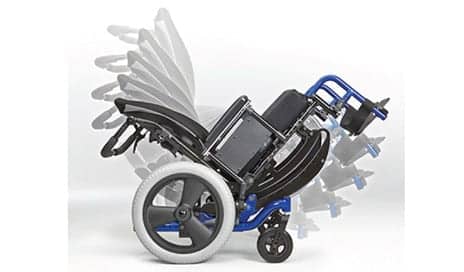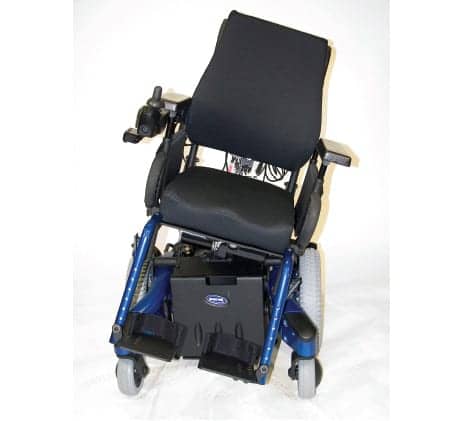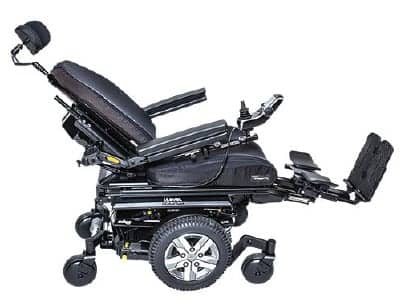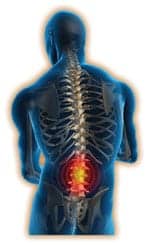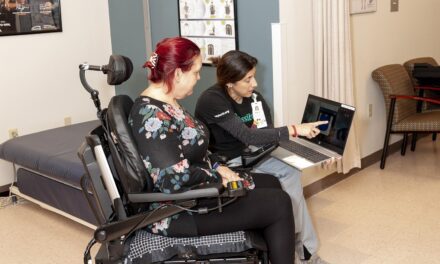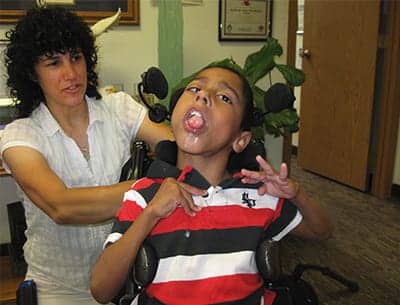
Securing an optimum seating system considers relationships between positioning technologies, accessories, and funding.
The majority of people using wheelchairs utilize consumer-level wheelchair seating and mobility. Clients using complex rehab technology – those people requiring more postural support and skin protection – often use tilt and recline technologies. Tilt and recline can be used separately or in combination on manual and power wheelchair bases. In order for the client to benefit from tilt and/or recline, the client must be positioned optimally within the seating system. When tilt and/or recline are used primarily for pressure redistribution and relief, these technologies work in conjunction with the seating system to minimize risk of pressure ulcer development. TILT SYSTEMS Tilt systems change the orientation in space of the client without changing the seated angles at the hips, knees, and ankles (see figure 1). Tilt rotates around a fixed or sliding pivot point.1 Most commonly, tilt systems move the client posteriorly, shifting more weight to the back and off of the buttocks. Tilt systems are also available that provide anterior and even lateral tilt. Many manual wheelchairs use a sliding pivot point. This reduces rearward tippiness and eases use of the tilt for the caregiver. Pushing a manual wheelchair that is tilted is difficult for a caregiver as the push handles are in a much lower position relative to the ground. For this reason, many bases include adjustable angle push handles, sometimes referred to as stroller handles. Self-propelling a manual wheelchair with tilt is difficult for two primary reasons. First, these bases are quite heavy and not generally configured for self-propulsion. Second, the client may be unable to reach the wheels, particularly when tilted. Several models are available that tilt in such a way as to keep the client in a more consistent position relative to the push wheel.
Manual tilt mechanisms are not designed for client operation. Several companies offer a power tilt which can be retrofitted to a manual wheelchair, allowing the client who is not using a power wheelchair to have independent control of their position in space. Funding is difficult for this option, as a caregiver is required to propel the wheelchair and so would be present to activate a tilt. However, a power tilt on a manual frame does provide independent control for a client who may not have a one-on-one attendant for several hours at a time, cannot otherwise shift their weight, and who is at risk of pressure ulcer development. Power tilt systems on a power wheelchair can be controlled directly through a toggle-style switch, through an external switch, or through the driving method. Additional electronics and programming may be required for through-drive control. Clinical indicators: Tilt is indicated in a variety of situations. Medical documentation must state why this technology is needed by an individual. A great resource that provides in-depth clinical indicators along with current research supporting these statements is the RESNA Position on the Application of Tilt, Recline, and Elevating Legrests for Wheelchairs Literature Update, approved this year. Some of the clinical indicators for tilt include:
- Postural management: by posteriorly tilting, the impact of gravity on the seated position is reduced and less trunk and head control is required to maintain upright. For clients with a fixed kyphosis, a posterior tilt can position the head over the pelvis, rather than forward of the pelvis, reducing forward flexion or hyperextension of the neck.
- Fatigue management: many clients fatigue due to young age, poor sleep at night, various medical conditions, or for a period of time after a seizure. Tilting the client reduces the effort required to sit upright, providing a position of rest or even allowing a nap.
- Medical management: some clients swallow with better control when partially tilted. Some medical care, such as accessing a gastrostomy button, is easier when the client is tilted.
- Pressure redistribution: When sitting upright, much of our weight is over the buttocks, posterior thighs, and the soles of the feet. Prolonged sitting in this position leads to compression and even deformation of tissues, decreasing oxygenation of these areas and increasing risk of pressure ulcer development. Tilt shifts some of this weight to the posterior trunk primarily, reducing pressure over other seated areas.
- According to research studies, posterior tilt in excess of 25 degrees is required to allow tissue perfusion around the ischial tuberosities (RESNA Position Paper).
Contra-indicators: Tilt is not indicated for everyone, however. Tilt-in-space manual wheelchairs are not designed for self-propulsion and are heavier than other manual wheelchair options. If a client does not meet the clinical indicators listed above, a tilt may not be required. Anterior tilt tips the client forward (see figure 2). Anterior tilt is sometimes available as a part of a posterior tilt system on manual and power wheelchairs. Some seating and mobility specialists use a mild anterior tilt to create a “task performance position.” By dropping the knees lower than the hips (in this case, via an anterior tilt), the pelvis tends to move into a slight anterior tilt, stabilizing the lower back and increasing function for some clients. Anterior tilt can also facilitate transfers.
Lateral tilt is available on some power wheelchairs (see figure 3). A fixed or dynamic lateral tilt may be used to balance the head over a pelvic obliquity and/or significant lateral scoliosis. A fixed lateral tilt can be achieved by simply using a wedge under the seating system. A dynamic powered lateral tilt is sometimes used for a client who requires pressure redistribution but is unable to tolerate a posterior pelvic tilt, most commonly due to tonic neck reflexes triggered when the head moves rearward.
Seating Considerations: Posterior tilt tips the client rearward, and so full back support and head support is indicated. Anterior tilt requires adequate anterior pelvic and trunk support to maintain alignment with the seating system. Lateral tilt may require lateral support at the trunk and pelvis to maintain client position in relation to the seating system. Many clients who utilize tilt technologies have moderate to significant postural support needs and often use complex seating systems, including molded seating systems. If a cushion is used, this must be secured adequately so that it does not slide out of position during tilt (ie, using a Velcro attachment). Some cushion materials, such as gel or air, may allow the client to move out of their ideal position during tilt as gravity is now pulling the client in a different direction. This could impact the effectiveness of the cushion to maintain the pelvis in a neutral position and must be assessed to ensure that the client’s position is maintained during the weight shift cycle, regardless of materials used. Different materials, such as foam or hybrid cushions, may be more appropriate if movement is detected. Pressure mapping can be used throughout the weight shift cycle, as well, to display changes in pressure under the ischial tuberosities. These readings can be used to determine optimal tilt angles to relieve pressure for that individual. RECLINE SYSTEMS Recline changes the seat to back angle of the wheelchair and seating system (see figure 4). Although available on manual wheelchairs, recline is more commonly used on power wheelchairs. Elevating leg rests are commonly used with recline. Recline is indicated for many of the same reasons as tilt systems. As the seat to back angle opens and closes, the client does not remain in precise alignment with the seating surfaces. This is called shear. Shear forces cause friction and drag on the client’s skin and underlying tissues, particularly on the sacral area, which can lead to pressure ulcer development. To compensate for this, a few manual and nearly all power recline systems use shear-reduction technologies, which lowers the back height as the seat to back angle opens and raises the back height as the seat to back angle closes.
Clinical Indicators: Recline, like tilt, can provide postural, fatigue, and medical management as well as redistribute pressure. As the hips are more extended, recline may expand medical management options to include urinal use, catheterization, diaper changes, and even dressing. Transfers may be easier to flat surfaces, such as a bed, from a reclined position. According to research, recline of greater than 100 degrees is required to provide adequate pressure relief at the ischial tuberosities (RESNA Position Paper). Contra-indicators: For some clients, opening the angle at the hips can lead to extension or spasms. Returning to an upright position can lead to a loss of pelvic position, with the client sliding into a posterior tilt. Seating considerations: Even with shear reduction, some movement occurs between the client and the seating system during recline. For this reason, molded seating systems are generally not recommended for recline systems. As the client returns to an upright position from recline, the pelvis may be pushed forward and then fall into a posterior pelvic tilt. Certain cushion materials are more likely to shift in response to these shear forces, leading to a loss of neutral pelvic position. Material selection of the seating surface, as well as the upholstery, must address these issues. Placement of secondary seating components such as lateral trunk supports needs be monitored throughout the entire weight shift cycle to ensure that pressures are not occurring (ie, at the axilla). A full-height back as well as a head support are required to provide a position of rest and adequate postural support during recline. COMBINATION SYSTEMS Combination tilt and recline systems have become increasingly popular over the years, and the technology has improved as well. These often include elevating leg rests. Although available on some manual wheelchairs, generally the degree of available recline is limited. Combination systems are most commonly used on power wheelchair bases. Combining these features has several additional clinical indicators over the use of these technologies in isolation. Clinical indicators: A primary advantage of using a combination of tilt and recline is improved pressure redistribution and relief over using these technologies in isolation. A second advantage is maintaining the client’s posture during the weight shift cycle over use of recline alone. By using a combination of tilt and recline movements, the position of the pelvis can be better maintained. This is accomplished by tilting rearward before closing the seat to back angle. A tilt of 35 degrees in combination with a recline of 100 degrees or 15 to 25 degrees of tilt with a recline of 120 degrees provides the greatest reduction in pressure (RESNA Position Paper). Power systems allow the client to adjust tilt and recline movements individually, as well as to activate preset combinations of movements to save effort and time. Contra-indicators: Using a combination system adds to the weight, expense, and complexity of a wheelchair, and so it is critical to evaluate and document if one of these technologies in isolation would meet a client’s needs. Seating considerations: As with recline, more aggressive seating systems are not indicated due to shear forces. These combination systems reduce the likelihood of the pelvis being pushed forward upon return to upright, and so a wider range of seating materials and upholstery can be considered. The client typically retains the ability to control each seating function separately, so loss of pelvic position is still a possibility and needs to be considered in seating selection. PRESSURE RELIEF GUIDELINES Common questions related to these technologies are “how much” and “how often.” Individual client needs vary, and so each weight shift plan will also vary. The Paralyzed Veteran’s Association (PVA) Consortium of Spinal Cord Medicine developed guidelines for people with spinal cord injuries and recommends that clients tilt at least 1 minute every 15 to 30 minutes. The RESNA Position Paper includes research studies that indicate that a 3-minute weight shift is more effective than a 1-minute weight shift. An important part of our equipment recommendations is to provide individual guidelines for use of tilt and/or recline, particularly in prevention of pressure ulcer development. FUNDING CONSIDERATIONS CMS and most major health plans in today’s reimbursement environment tend to review all mobility-related submittals in a more rigorous and detailed manner than ever before. The benchmark most commonly utilized in reviewing claims for power seating is Medicare’s LCD (Local Coverage Determination) for Wheelchair Options/Accessories (L11462). While the policy guidelines surrounding provision of power seating have not fundamentally changed over the last 5 years, the stringency of the review process has increased exponentially, resulting in significantly higher denial rates for complex seating and mobility systems. Objective clinical documentation is required that clearly describes the client’s mobility impairment. This documentation must also relate specific deficits to the client’s inability, in absence of the prescribed power function, to do the following: 1) effectively weight shift (with high risk of pressure ulcer development); 2) manage spasticity; and/or 3) intermittently catheterize (with the inability to transfer from the wheelchair to a bed). Subjective narrative which “paints the picture” of client need for prescribed seat functions must be paired with objective measures that substantiate the clinical need for the recommended system. Less costly alternatives must be specifically ruled out, and the medical record cannot contain contradictory information. When possible, it is extremely helpful to reference supporting evidence-based research when submitting these types of claims. It is important to recognize that there are a host of functional/clinical indicators for power seating beyond those referenced in the LCD for power seating. Mitigating factors such as swallowing, respiration, positioning for completion of MRADL tasks, rest, transfers, and line of sight are all valid clinical considerations in the prescription of tilt/recline. However, these factors do not constitute coverage criteria per the Medicare LCD. The relatively narrow scope of coverage criteria can be a limiting factor in obtaining appropriate seat functions, and this must be kept at the forefront of the clinician’s mind during the documentation process. Additionally, because the LCD does not provide differential criteria for single-function versus multifunction systems, uncertainty exists as to what constitutes “adequate” clinical justification for multifunction systems. It is clear that clinical documentation for multifunction systems must meet established coverage criteria and specifically state why a single-function system alone will not meet the client’s medical need. Objective measures such as comparative pressure mapping, specific strength/balance/ROM deficits, and the results of failed equipment trials with a single-function system are all helpful in building the case for funding. Regardless of the type of seating system selected for your client — manual or power, single or multifunction — documentation that both “paints the picture” of individual need and contains objective measures to back it up, is the key to reimbursement. Michelle L. Lange, OTR/L, ABDA, ATP/SMS, has more than 25 years of experience and is former clinical director of The Assistive Technology Clinics of The Children’s Hospital of Denver. She lectures globally, and has authored six book chapters and nearly 200 articles. She is editor of Fundamentals in Assistive Technology, 4th ed, and clinical editor of NRRTS Directions. Eric Grieb, ATP, CRTS, OTR/L, earned a BS in occupational therapy from Colorado State University in 1992. He has worked in the clinical subspecialty of Seating and Wheeled Mobility for the last 20 years as a clinician and supplier of complex rehabilitation technology. For more information, contact [email protected]. Reference:
- http://www.karmanhealthcare.com/wheelchairs/manual-wheelchairs/tilt-wheelchairs. “Tilt Wheelchairs.” Accessed October 9, 2015.
Resources: RESNA Position on the Application of Tilt, Recline, and Elevating Legrests for Wheelchairs Literature Update, 2015, www.resna.org, pending publication. PVA Consortium of Spinal Cord Medicine, Pressure Ulcer Prevention and Treatment following SCI, 2nd Edition. Local Coverage Determination (LCD) for Wheelchair Options/Accessories (L11462).

